Gala pork and egg pie
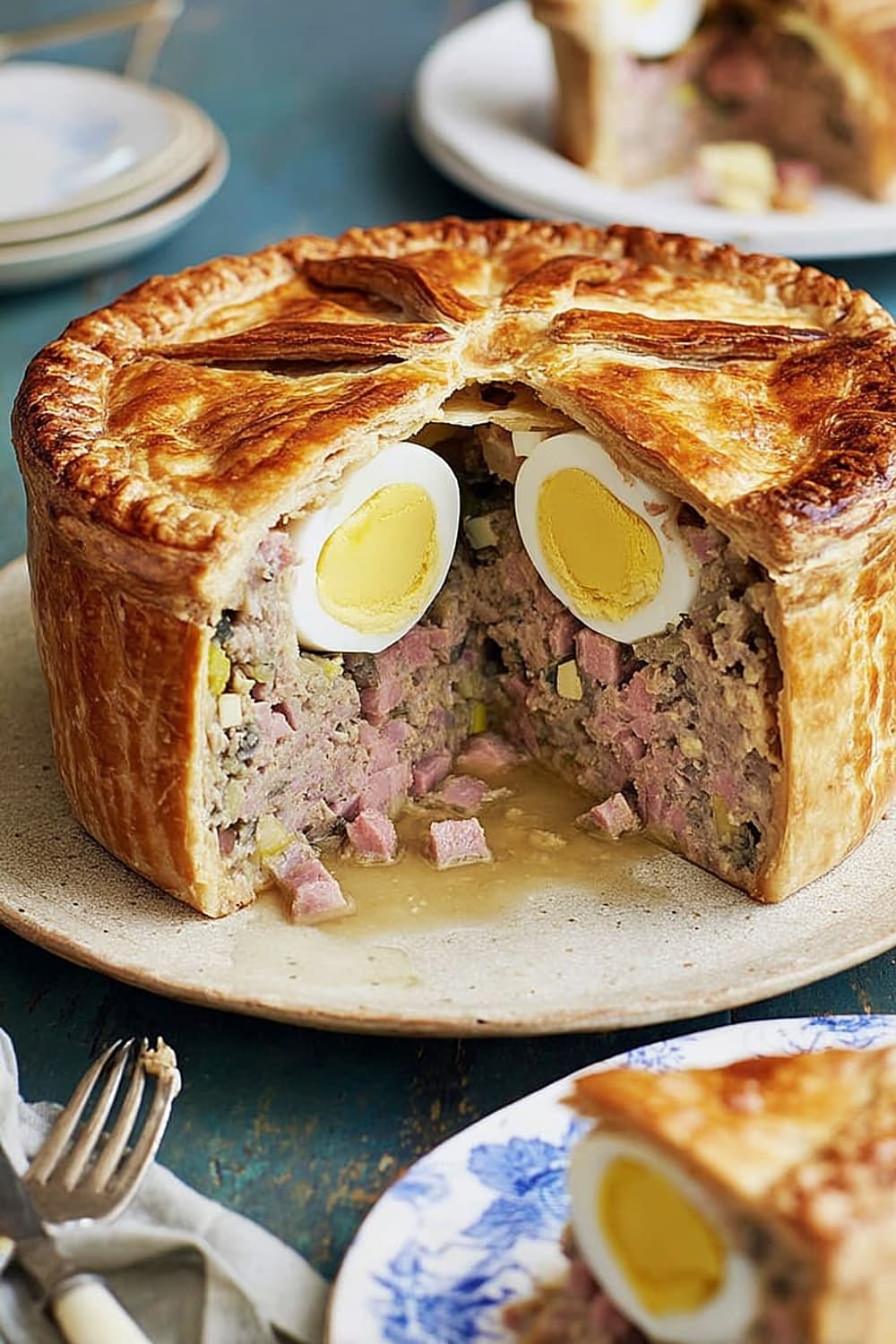
This isn’t just a pie—it’s basically edible architecture that happens to taste incredible and makes you look like you’ve got serious culinary skills.
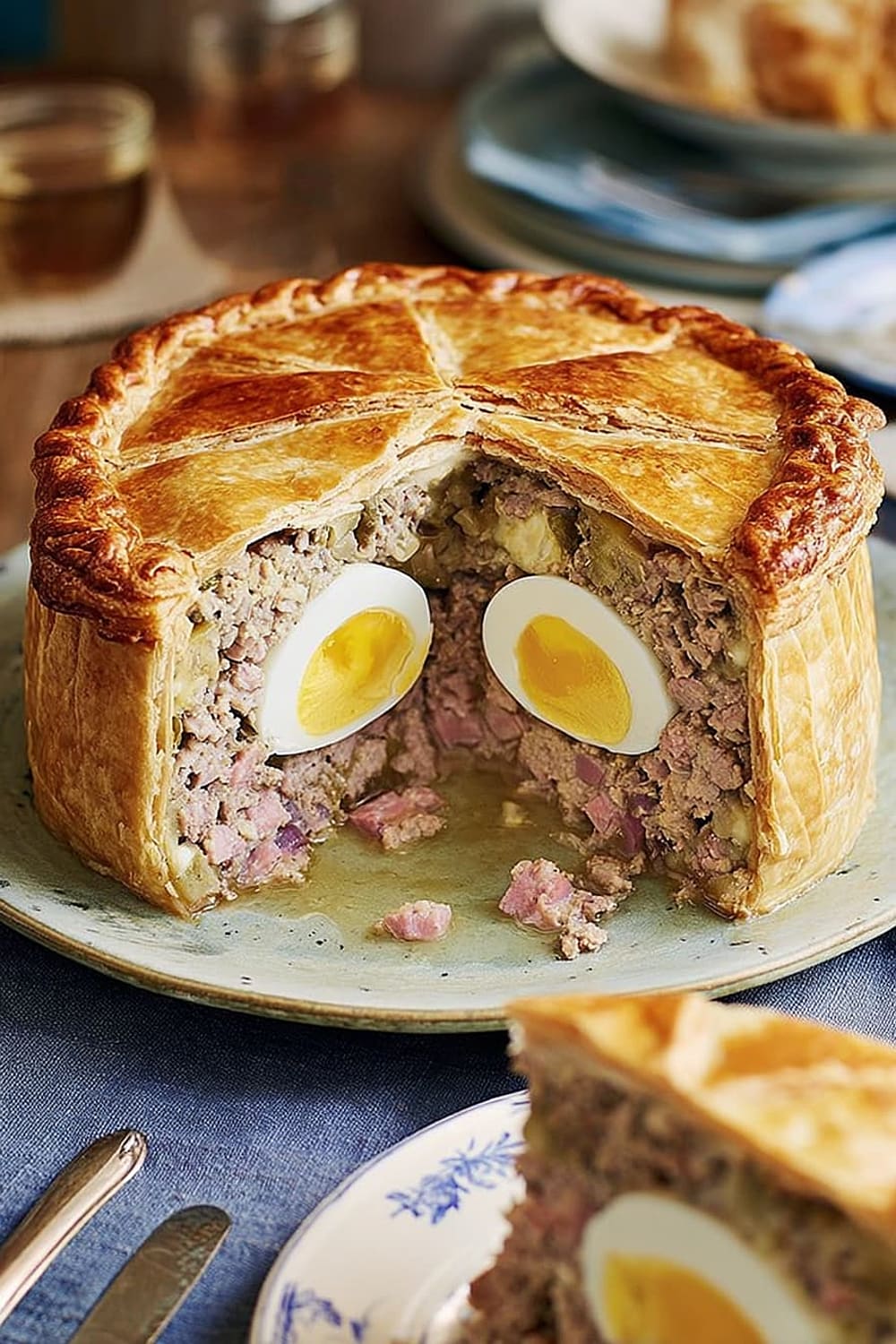
Picture slicing through that golden, flaky hot water pastry crust to reveal perfectly arranged hard-boiled eggs nestled in seasoned pork and bacon, all held together with a savory aspic jelly that adds the most satisfying wobble.

The combination of textures here is absolutely genius: tender chunks of outdoor-bred pork belly mixed with smoky bacon lardons, fresh thyme, and those little pops of briny green peppercorns that add just the right amount of surprise.
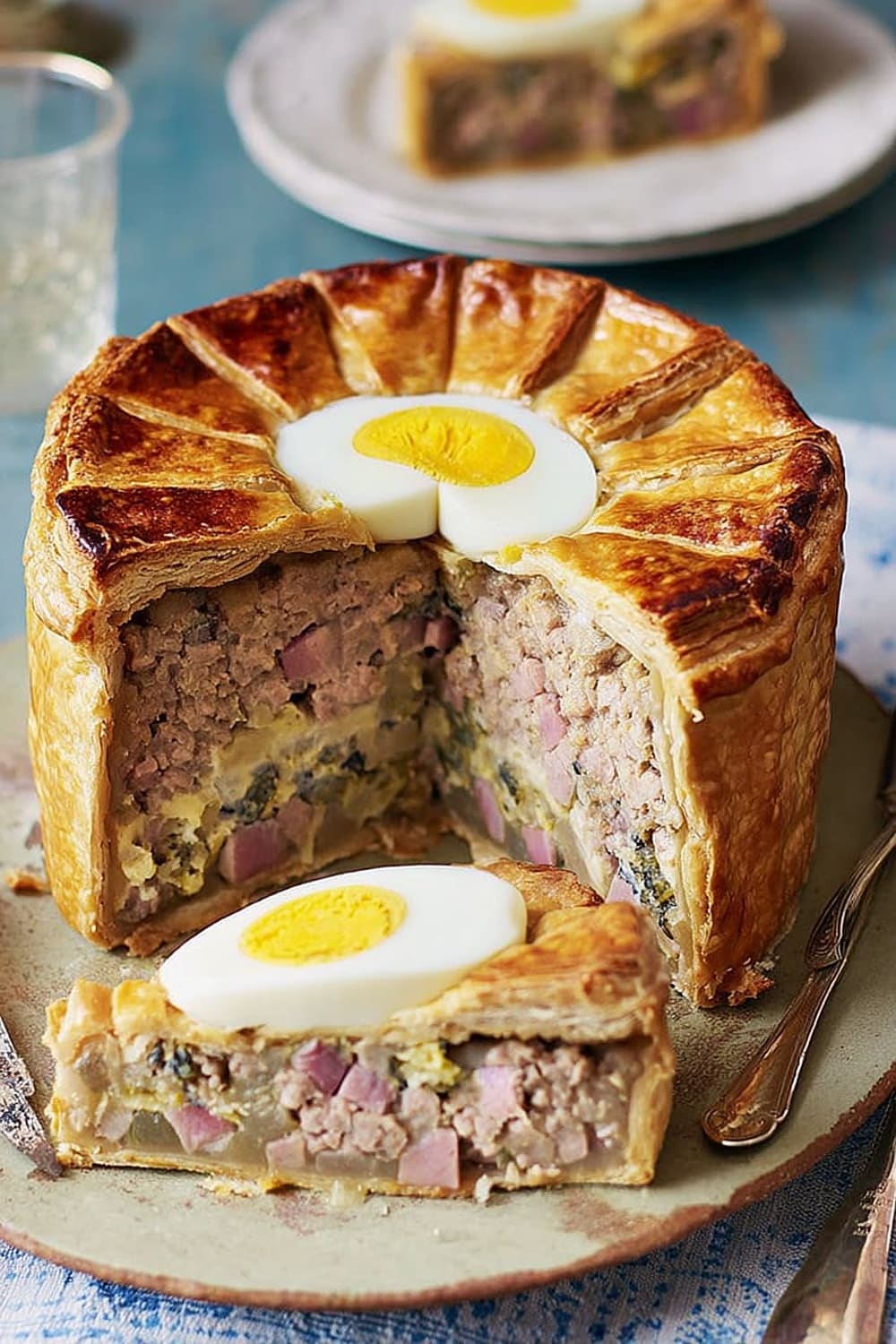
Yes, this recipe takes some time and patience, but most of that is hands-off cooling and chilling time while you do literally anything else.
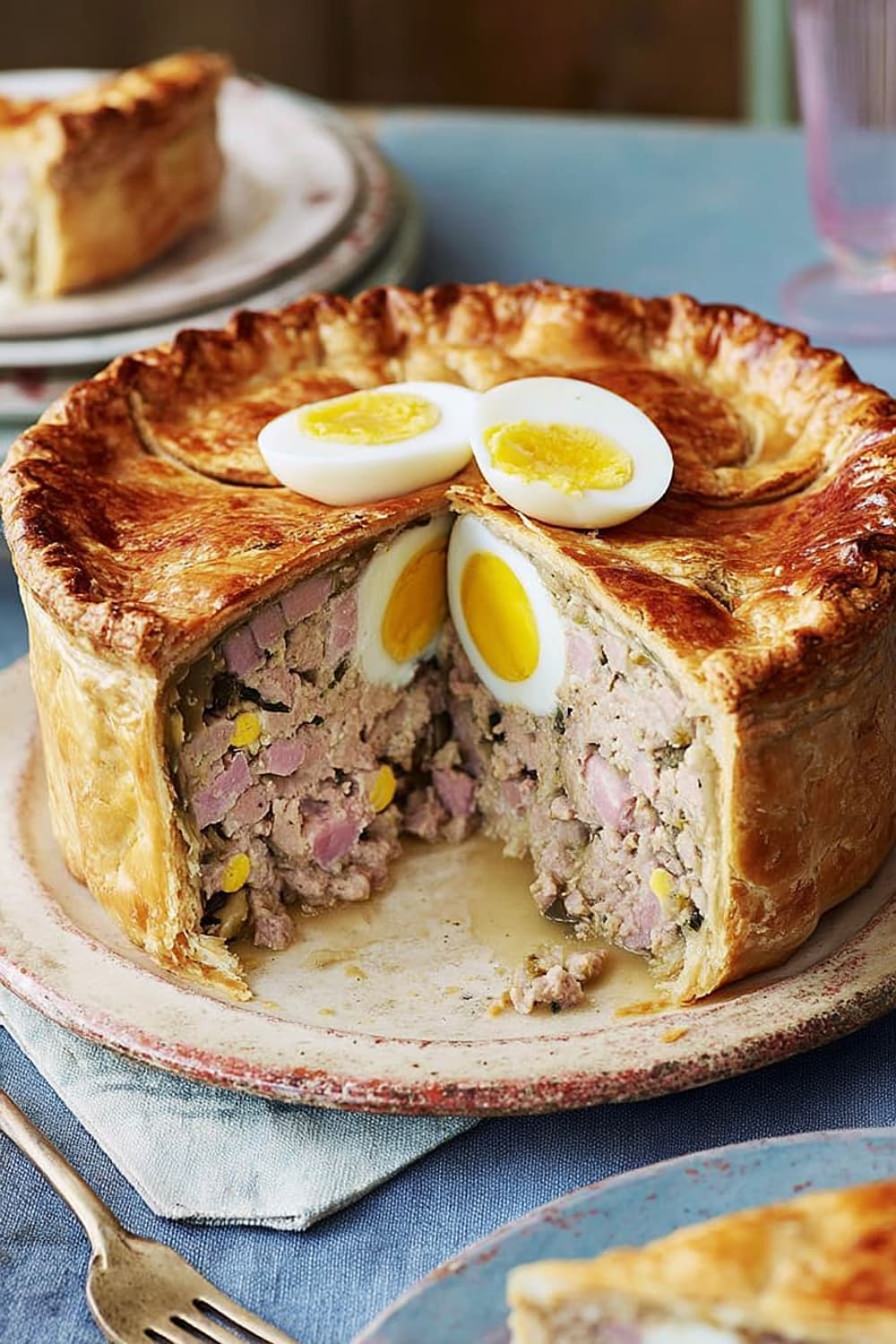
The hot water pastry might sound intimidating, but it’s actually more forgiving than regular pastry—the lard and warm water create a dough that’s sturdy enough to hold all that gorgeous filling without falling apart.
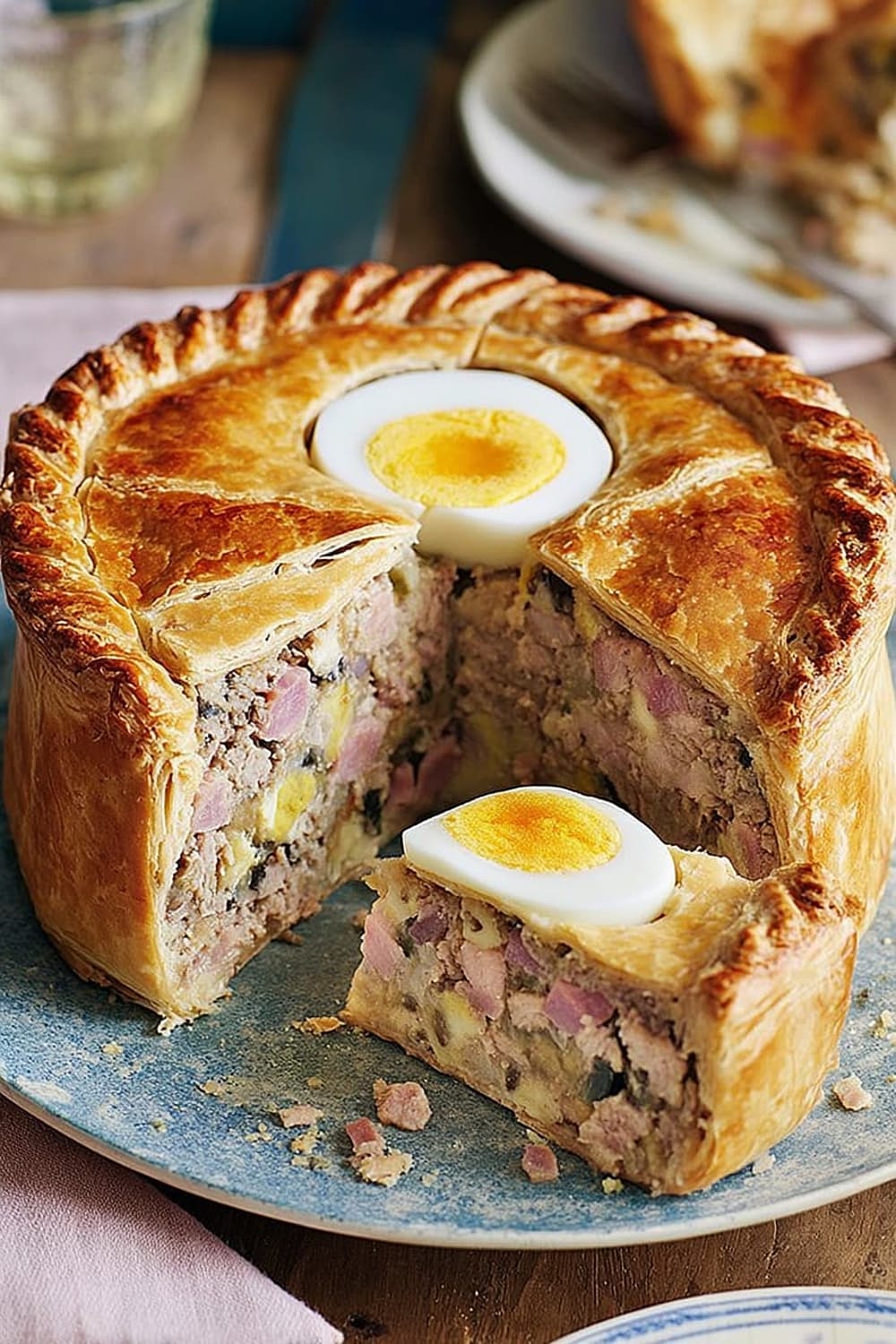
When you slice into this beauty and see those perfect egg cross-sections surrounded by seasoned meat, you’ll understand why gala pies have been impressing people for centuries.
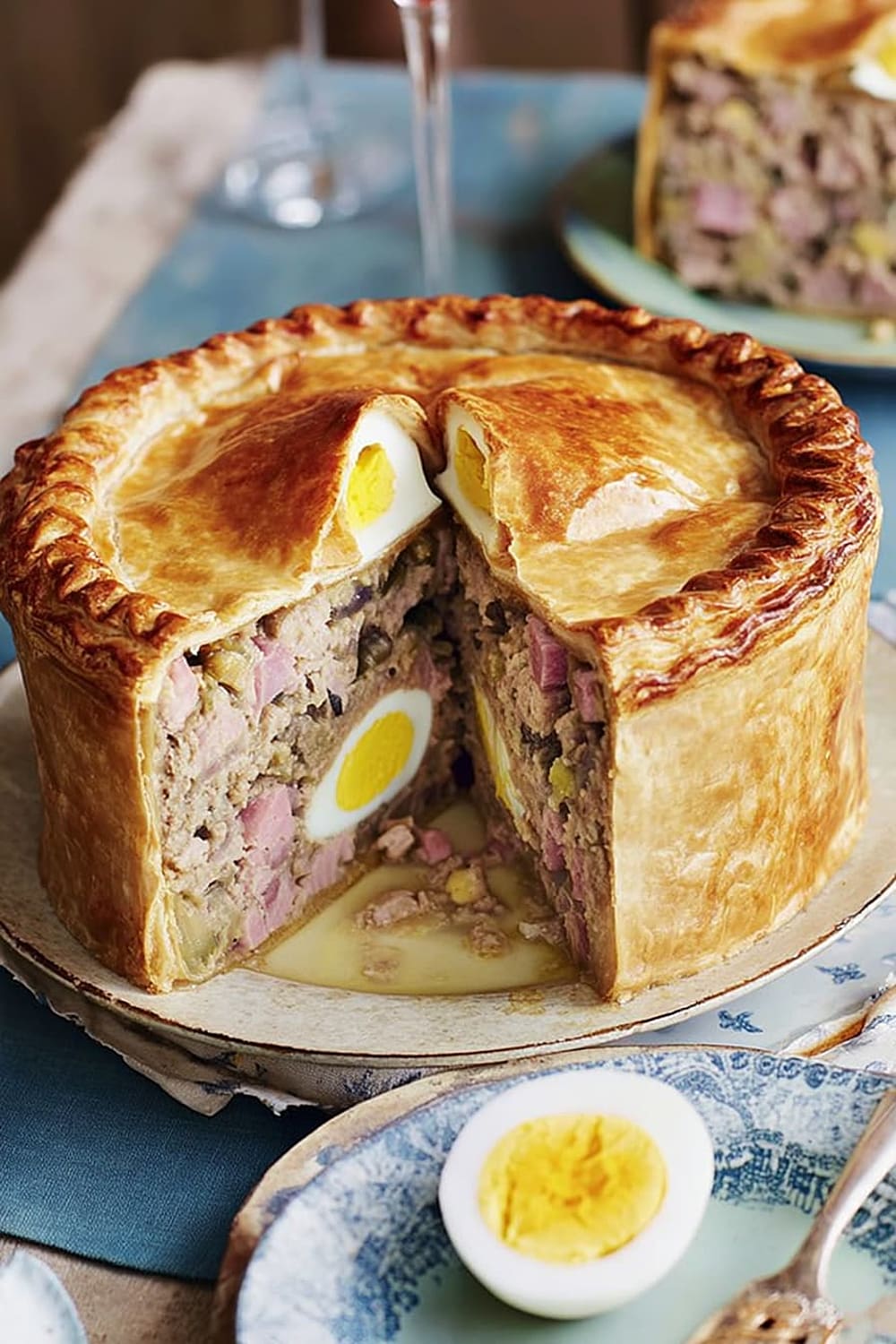
Ingredients
For the filling
- 750 g British outdoor-bred pork belly, cubed
- 250 g British outdoor-bred bacon lardons or streaky bacon, chopped
- Small bunch fresh thyme, leaves only, chopped
- 1 tbsp green peppercorns in brine, drained
- Handful fresh breadcrumbs
- 1 tsp ground white pepper
- ½ tsp ground black pepper
- A good pinch ground mace
- 5 medium free-range eggs, at room temperature
For the hot water pastry crust
- 200 g lard (from British outdoor-bred pigs, if possible)
- 500 g plain flour, plus extra to dust
- ½ tsp salt
- 1 medium free-range egg, plus 1 extra for glazing
For the jelly
- 350 ml chicken or pork stock
- 5 gelatine leaves
Essential equipment
- 20 cm x 7cm pie dish or cake tin
- Small funnel
Recommended tools
- Mincer or food processor
- Digital probe thermometer
Instructions
Prepare the meat filling
- 1 Mix the 750g pork belly with the 250g bacon lardons, then put half the mixture through a mincer or food processor. If using a food processor, pulse to achieve a relatively fine consistency without turning it into paste. The key is maintaining some texture while breaking down the meat enough to bind well.
- 2 Dice the remaining meat mixture into 1cm cubes by hand using a large, sharp chef’s knife on a large cutting board. This two-texture approach creates the traditional chunky consistency that makes gala pie so satisfying to bite into—you’ll get both smooth and chunky textures in every slice.
- 3 Combine the chopped and minced meat in a large mixing bowl. Add the chopped fresh thyme, 1 tbsp drained green peppercorns, and handful of fresh breadcrumbs. Season with 1 tsp white pepper, ½ tsp black pepper, ground mace, and a generous pinch of salt. Mix thoroughly to distribute seasonings evenly, cover, and refrigerate while you prepare the eggs and pastry.
Prepare the eggs
- 4 Bring a large pan of water to a rolling boil. Gently add the 5 room-temperature eggs and boil for exactly 7-8 minutes for perfectly set but not overcooked yolks. Using room-temperature eggs prevents cracking when they hit the hot water.
- 5 Immediately drain the eggs and cool under cold running water for 2-3 minutes to stop the cooking process. Peel carefully and set aside. The eggs should be firm but not rubbery—this timing creates the ideal texture for slicing later.
Make the hot water pastry
- 6 Put the 200g lard and 170ml cold water in a saucepan and warm over low heat until the fat has completely melted. The water doesn’t need to boil—you just want the lard fully liquified and the mixture warm enough to work with the flour.
- 7 Combine the 500g plain flour and ½ tsp salt in a large mixing bowl. In a separate small bowl, lightly beat 1 egg. Pour the warm lard and water mixture into the flour, add the beaten egg, and bring together with a wooden spoon or your hands.
- 8 Transfer the dough to a clean work surface and fold and gently knead 4-5 times until smooth. Don’t overwork it—hot water pastry should come together quickly. Cool the pastry in the refrigerator until it reaches room temperature or below, about 30-45 minutes. This makes it much easier to roll and handle.
Assemble and bake
- 9 Heat your oven to 200°C/180°C fan/gas 6. Set aside one quarter of the pastry for the pie lid. Shape the remaining three-quarters into a disc, then roll it out on a lightly floured work surface to a large circle roughly 30cm in diameter. The pastry should be about 3-4mm thick.
- 10 Carefully lay the pastry in the base of your 20cm x 7cm pie dish, bringing it up the sides and smoothing out any pleats as you go. Make sure there are no holes or thin spots, and leave a slight pastry overhang all around the rim. Press gently into corners without stretching the pastry.
- 11 Fill the lined tin with enough pork mixture to come one-third of the way up the pastry sides. Arrange the 5 peeled eggs end-to-end in a circle on top of the filling—they should fit snugly but not be cramped. Fill in the gaps around the eggs with small spoonfuls of the remaining meat mixture, then layer the rest of the pork over the eggs to the top of the pastry.
- 12 Beat the extra egg for glazing in a small bowl and brush the pastry edges with some of it. Roll out the remaining pastry for the lid to fit the top of your pie. Carefully position the lid and crimp the edges together firmly, trimming any excess overhang. Use the tip of a sharp knife to make a small hole in the center of the lid for steam to escape.
Bake and finish
- 13 Transfer to the oven and bake for 20 minutes at the higher temperature, then reduce the oven to 180°C/160°C fan/gas 4. Brush the entire top surface with the remaining beaten egg for a beautiful golden finish, then return to the oven for 1 hour or until the internal temperature reaches 66°C on a digital probe thermometer inserted through the center hole.
- 14 For the jelly, warm the 350ml stock in a small saucepan over low heat. Meanwhile, soak the 5 gelatine leaves in cold water for 3-4 minutes until softened. Remove the leaves, squeeze out excess water, and stir into the hot (not boiling) stock until completely dissolved.
- 15 Remove the pie from the oven and let both the pie and the stock mixture cool to room temperature for 1-2 hours. Turn out the cooled pie and set it upright on a serving platter. Position a small funnel in the hole in the top of the pie and slowly pour in enough stock to reach the top—you may not need all of it.
- 16 Refrigerate the completed pie for 6-8 hours or overnight before serving. This chilling time allows the jelly to set properly and makes the pie much easier to slice cleanly.
Recommended Equipment and Kitchen Tools
Essential Tools (for best results)
- Large cutting board – You’ll need plenty of space for dicing the pork belly and bacon into uniform pieces, which is crucial for even cooking and professional presentation
- Sharp chef’s knife – A quality 8-10 inch blade makes quick work of cubing the meat and ensures clean, even cuts that cook uniformly
- Digital probe thermometer – Takes the guesswork out of doneness; the center should reach exactly 66°C for food safety without overcooking
- 20cm x 7cm deep pie dish – The specific dimensions ensure proper pastry-to-filling ratio and even baking
Helpful Upgrades
- Stand mixer with paddle attachment – Makes combining the hot water pastry ingredients effortless and prevents overworking the dough
- Kitchen scale – British recipes work best with weight measurements; 750g of pork belly will give you consistent results every time
- Food processor or mincer – Creates the perfect texture for half the meat filling, though hand-chopping works if you don’t mind the extra effort
- Small funnel – Essential for adding the stock jelly without making a mess; a makeshift paper funnel works in a pinch
Nice-to-Have Options
Pastry brush – Gives you better control when applying the egg wash for that gorgeous golden finish
Bench scraper – Helps transfer diced meat and keeps your work surface organized during prep
Silicone spatula – Perfect for scraping every bit of seasoned meat mixture from your mixing bowls
Remember, these tools make the process smoother and more enjoyable, but don’t let missing equipment stop you from making this impressive pie—good technique matters more than fancy gadgets.
Recipe Variations and Dietary Modifications
Traditional British Variations
- Melton Mowbray style – Omit the bacon and use only pork shoulder and belly for a more traditional approach; increase pork to 1kg total
- Game pie version – Replace half the pork with diced venison, pheasant, or rabbit for a more rustic, countryside flavor
- Scotch pie adaptation – Use mutton instead of pork and add chopped onions to the filling for a Scottish twist
Meat Substitutions
- Chicken and ham gala pie – Replace pork belly with 500g diced chicken thighs and 250g ham hock for a lighter but still rich version
- Turkey and cranberry – Use 750g turkey thigh meat with dried cranberries instead of green peppercorns for a festive variation
- Mixed game meats – Combine equal parts pork, venison, and duck for an elevated version perfect for special occasions
Pastry Modifications
- Butter pastry version – Replace lard with cold butter for a different flavor profile, though the pastry will be less sturdy
- Gluten-free adaptation – Use a blend of rice flour, potato starch, and xanthan gum, but expect a more fragile crust that requires careful handling
- Herb-infused pastry – Add finely chopped rosemary or thyme directly to the flour for extra flavor throughout
Filling Enhancements
- Mushroom and herb – Add 200g finely diced mushrooms sautéed until dry, plus extra fresh herbs like sage or marjoram
- Cheese addition – Incorporate 100g grated mature cheddar into the meat mixture for extra richness
- Spiced version – Add ground coriander, fennel seeds, and a pinch of nutmeg for a more complex spice profile
Size Variations
- Individual pies – Divide mixture among 6-8 small pie tins, reduce baking time to 45-50 minutes total
- Large family pie – Double the recipe and use a 25cm dish, increase baking time by 15-20 minutes
Nutritional Information and Health Benefits
Key Nutritional Highlights
This traditional gala pie provides approximately 450-500 calories per serving when cut into 8 portions. The combination of outdoor-bred pork belly and bacon delivers high-quality protein (about 25g per serving) along with essential amino acids needed for muscle maintenance and repair. The free-range eggs contribute additional protein plus important nutrients like choline for brain health and selenium for immune function. The hot water pastry crust provides energy-giving carbohydrates, while the fresh thyme adds antioxidants and the green peppercorns contribute small amounts of vitamin C and beneficial plant compounds.
Health Benefits of Main Ingredients
The outdoor-bred pork contains higher levels of omega-3 fatty acids compared to conventionally raised pork, plus important B vitamins including B12 for energy metabolism and nervous system function. Free-range eggs provide complete protein and lutein for eye health, while their room-temperature preparation ensures optimal nutrient retention. Fresh thyme contains thymol, a natural antimicrobial compound, plus vitamin K for bone health. The gelatine-rich stock supports joint health and provides collagen that benefits skin elasticity. Green peppercorns offer antioxidants and may help with digestion, while the traditional lard provides stable saturated fats that support hormone production.
Dietary Considerations
This recipe contains gluten (wheat flour), eggs, and pork products, making it unsuitable for those with celiac disease, egg allergies, or dietary restrictions avoiding pork. The dish is naturally dairy-free and fits well into traditional British, high-protein, and moderate-carb eating patterns. Portion control is important due to the rich nature of the ingredients—one slice provides substantial nutrition and satisfaction. This pie works excellently as part of a balanced meal when served with fresh salads or steamed vegetables to add fiber and additional vitamins.
Smart Swaps and Ingredient Substitutions
Meat Substitutions:
- Pork belly → Pork shoulder (use same amount, slightly leaner but still flavorful)
- Bacon lardons → Pancetta or thick-cut bacon chopped into small pieces
- British outdoor-bred → Any high-quality pork (flavor will be similar, though texture may vary slightly)
Pastry Alternatives:
- Lard → Butter (use 180g cold butter, expect different texture and flavor)
- Plain flour → Strong bread flour (creates sturdier pastry, use same amount)
- Free-range eggs → Standard eggs (nutrition slightly different, technique identical)
Seasoning Swaps:
- Green peppercorns → Capers or juniper berries (similar briny pop of flavor)
- Fresh thyme → Dried thyme (use 1 tsp dried instead of fresh bunch)
- Ground mace → Nutmeg or allspice (similar warm, aromatic quality)
- White pepper → Additional black pepper (slightly different heat profile)
Stock and Jelly Options:
- Chicken stock → Vegetable stock or beef stock (affects final flavor depth)
- Gelatine leaves → Powdered gelatine (use 1 packet/7g, dissolve in cold water first)
- Homemade stock → Quality store-bought (choose low-sodium versions)
Budget-Friendly Swaps:
- Outdoor-bred pork → Standard pork belly (still delicious, slightly different texture)
- Fresh breadcrumbs → Panko or dried breadcrumbs (use slightly less as they’re denser)
Emergency Pantry Substitutions:
- No mincer → Food processor or very fine hand chopping (texture slightly different but works well)
- No pie dish → Cake tin or loaf pan (adjust baking time accordingly)
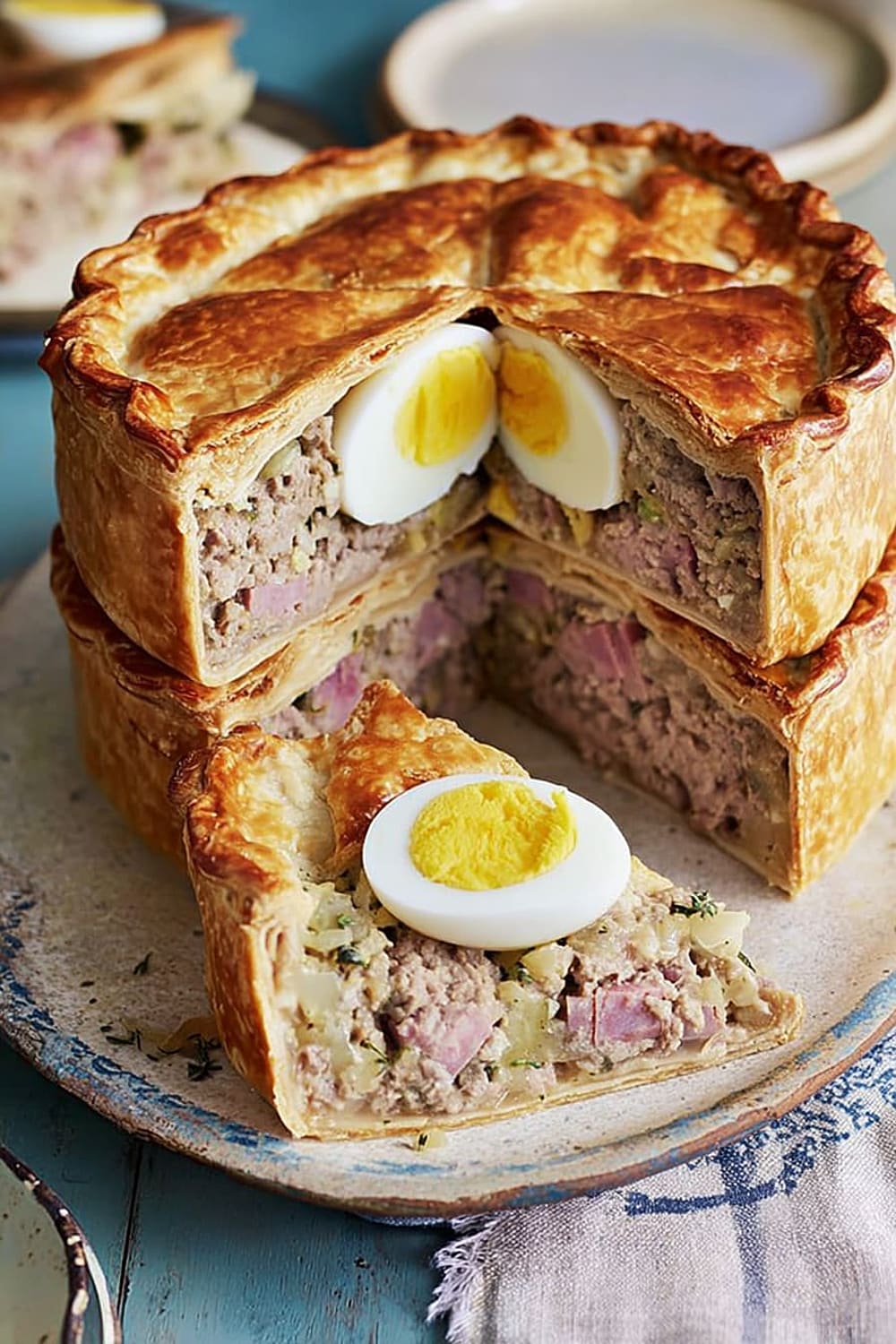
Make It Diabetes-Friendly
Carb Reduction Strategies:
- Replace traditional pastry → Almond flour crust using 300g almond flour + 2 eggs + 50g butter for a lower-carb alternative that reduces carbs by approximately 60%
- Reduce pastry thickness → Roll thinner and use less pastry overall, cutting carbs by 25-30% per slice
- Portion control approach → Cut into 10 smaller slices instead of 8, reducing carbs from approximately 25g to 20g per serving
Filling Modifications:
- Increase protein ratio → Add extra eggs (6-7 instead of 5) to boost protein and create more satisfying portions with stable blood sugar impact
- Vegetable additions → Mix in 200g finely diced mushrooms or bell peppers to add fiber and reduce the density of higher-carb ingredients
- Breadcrumb substitute → Use crushed pork rinds or ground almonds instead of breadcrumbs to eliminate those carbs entirely
Smart Serving Strategies:
- Pair with high-fiber sides → Serve with mixed green salad or roasted low-carb vegetables to slow digestion and moderate blood sugar response
- Timing considerations → Eat as part of a balanced meal rather than alone, including healthy fats and fiber to minimize glucose spikes
- Portion awareness → One slice provides approximately 20-25g carbs depending on modifications, so plan accordingly within daily carb targets
Estimated Carb Reduction: Traditional version: ~25g carbs per slice | Modified version: ~12-15g carbs per slice
Blood Sugar Benefits: The high protein and fat content naturally helps slow carb absorption, making this a more blood-sugar-friendly option than many baked goods
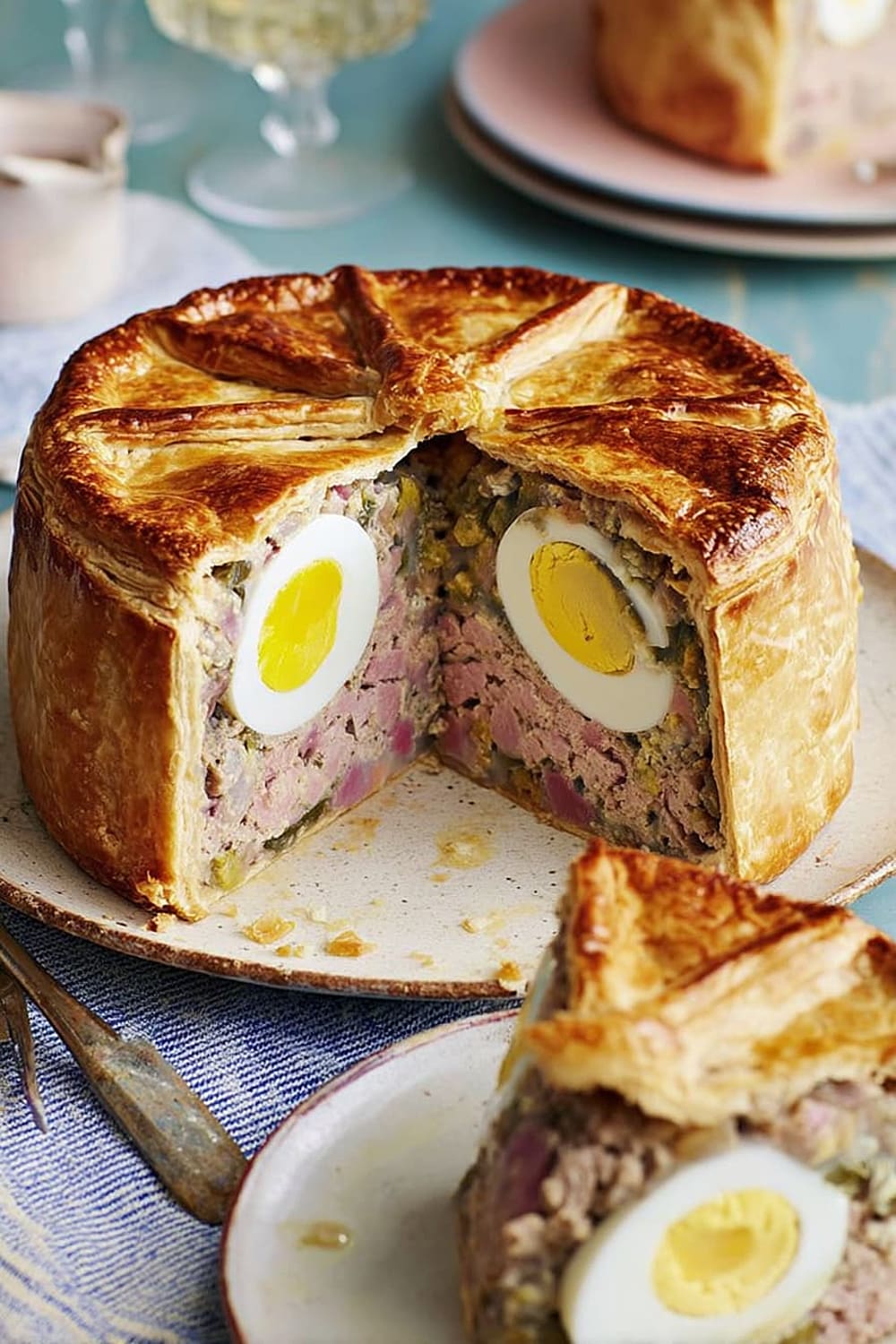
Perfect Pairing Suggestions
Beverage Pairings
A robust English bitter or brown ale complements the rich pork and savory pastry beautifully, while the hop bitterness cuts through the fat content perfectly. For wine lovers, a medium-bodied red like Côtes du Rhône or English Pinot Noir matches the meat’s richness without overwhelming the delicate egg and herb flavors. Non-alcoholic options include sparkling apple cider or ginger beer, both providing refreshing acidity that cleanses the palate between bites. Strong black tea or Earl Grey work wonderfully for afternoon serving, following traditional British pub meal customs.
Side Dish Recommendations
Tangy pickled onions and cornichons provide essential acidity to cut through the rich pastry and meat, while English mustard or wholegrain mustard adds sharp heat that enhances the pork flavors. A simple mixed green salad with sharp vinaigrette offers fresh contrast to the heavy pie, and roasted root vegetables like parsnips and carrots complement the traditional British flavor profile. Bubble and squeak or mashed swede continue the comfort food theme while adding different textures and flavors.
Complete Meal Ideas
Start with potted shrimp or Welsh rarebit as appetizers that maintain the British theme without competing with the pie’s richness. For a summer picnic spread, add Scotch eggs, cheese and pickle sandwiches, and fresh strawberries with cream for dessert. Winter entertaining calls for leek and potato soup as a starter, followed by the pie with braised red cabbage and roasted Brussels sprouts, finishing with sticky toffee pudding.
Occasion Suggestions
Perfect for Boxing Day buffets, summer picnics, pub lunch gatherings, or traditional British dinner parties. The make-ahead nature makes it ideal for entertaining since it’s served cold and actually improves in flavor overnight. Sporting events and outdoor concerts are perfect venues since it travels well and requires no reheating.
Pro Tips and Troubleshooting
Professional Pastry Techniques
Keep your hot water pastry warm while working—if it gets too cool, it becomes difficult to roll and may crack. Work quickly but gently, and if the pastry does cool too much, briefly knead it to warm it up again. When lining your pie dish, avoid stretching the pastry as this causes shrinkage during baking. Instead, ease it into corners and up the sides naturally. The pastry should feel slightly greasy to the touch—this is normal and creates the characteristic sturdy texture that holds the heavy filling.
Common Mistakes and Solutions
Soggy bottom prevention: Ensure your oven is fully preheated and consider placing the pie on a preheated baking stone or heavy baking sheet for the first 20 minutes. Cracked pastry usually results from pastry that’s too cool—warm it slightly before rolling. Leaking filling happens when there are holes in the pastry or poor crimping—check carefully and seal edges with beaten egg. Overcooked eggs create an unpleasant gray ring around the yolks—stick to the 7-8 minute timing and cool immediately in cold water.
Storage and Make-Ahead Strategies
This pie actually improves in flavor when made 1-2 days ahead, allowing the jelly to set completely and flavors to meld. Store covered in the refrigerator for up to 5 days. Don’t freeze the completed pie as the jelly doesn’t freeze well, but you can freeze the baked pie before adding the stock, then thaw and add jelly later. Transport carefully to maintain the jelly’s integrity—keep chilled and level during transport.
Scaling and Presentation
To double the recipe, use a larger rectangular dish rather than making two round pies—this prevents overcooking edges. Individual portions work well for entertaining; use 4-inch pie tins and reduce baking time to 45-50 minutes. Professional slicing requires a very sharp knife wiped clean between cuts—warm the blade slightly under hot water for cleaner cuts through the jelly.
This gala pork and egg pie represents everything wonderful about traditional British baking—it’s impressive enough for special occasions yet comforting enough for everyday enjoyment. The combination of techniques might seem complex, but each step builds logically toward that perfect moment when you slice through the golden pastry to reveal the beautiful cross-section of eggs nestled in seasoned pork, all held together with that wobbly, savory jelly that makes each bite absolutely perfect.